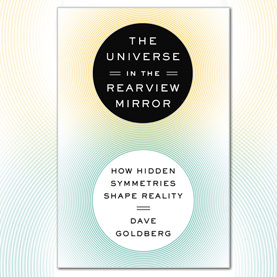It’s not every day that you find a Physics book that is both wonderfully thorough and wildly entertaining – but, then again, it’s not every day that Dave Goldberg publishes a book; he’d be quite the busy boy if that was the case. But as writer for the fantastic Ask a Physicist column on io9.com (seriously, check it out), professor and director of undergraduate studies at Drexel University, Slate and LA Times contributor, husband and father – he’s plenty busy already. As an avid reader of Ask A Physicist, I was already familiar with his entertaining writing style – but getting to enjoy it in a full-length book was quite the treat.
Enter The Universe In The Rearview Mirror. Although many recent physics books focus almost entirely on the oddities of quantum mechanics, Goldberg steps outside the now almost tiresome discussions of randomness and Schrodinger’s Cat to enlighten readers on a topic less often discussed, but just as (if not more) fascinating – symmetry. Goldberg’s perusal of symmetry extends far beyond your Elementary School-inspired notions of bilaterally symmetric shapes into questions about the origins, shape and inevitable fate of the universe – among many others!
At most times in Rearview Mirror, Goldberg’s style feels more like a discussion than a book – it’s as if your delightfully nerdy friend from college (the one with a knack for identifying stars, he’s convinced it’s a total turn-on) came over for dinner one night to talk about his favorite topic – the mysteries of the cosmos. Even with the conversational essence, Goldberg is sure to never get bogged down in scientific jargon,instead he frequently relies on allusions and analogies to get his point across.
In the book’s first five pages alone Goldberg makes creative allusions to Star Wars, Angels & Demons, Isaac Asimov, The Incredible Hulk, Twilight , and Star Trek. In the world of science writing since The Big Bang Theory, countless authors have tried to appeal to the “nerdy” sub-genre, but the allusions and comparisons in most books typically seem forced, even irrelevant at times. Perhaps due to his extensive teaching experience, this is never the case with Goldberg’s writing – every allusion is spot-on and fascinating, even Feynman-like at times. Never before had I thought of Lewis Carroll’s Alice jumping down the rabbit hole when discussing a black hole, and now I’ll never be able to think of taking the plunge without doing so.
Throughout the slightly-over-300-page-
Once the journey is over, readers will not only have a thorough understanding of how symmetry truly shapes our universe, but also a plethora of exciting dinner conversations sure to spice up any date – “Hey, did you know that poker can teach us a lot about entropy?”

